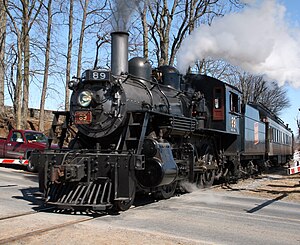Locomotive wheel arrangement
2-6-0 (Mogul) Front of locomotive at left
First known "True type" version First use 1860 Country United States of America Railway Louisville & Nashville Railroad Evolved from 2-4-0 Evolved to 2-6-2 Benefits Better adhesion with 6 coupled drivers Drawbacks Small drivers limited speed
Under the Whyte notation for the classification of steam locomotives , 2-6-0 wheel arrangement of two leading wheels on one axle, usually in a leading truck , six powered and coupled driving wheels on three axles and no trailing wheels . This arrangement is commonly called a Mogul .[1]
^ White, John H. Jr. (1968). A history of the American locomotive; its development: 1830–1880. New York: Dover Publications. pp. 62–65. ISBN 0-486-23818-0


